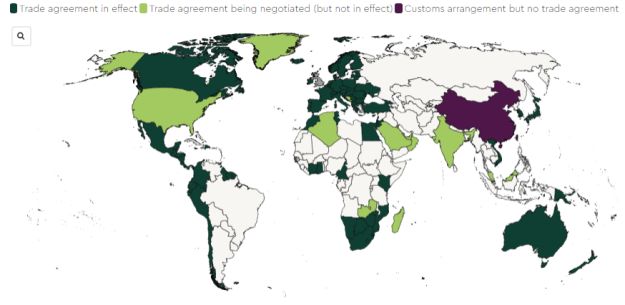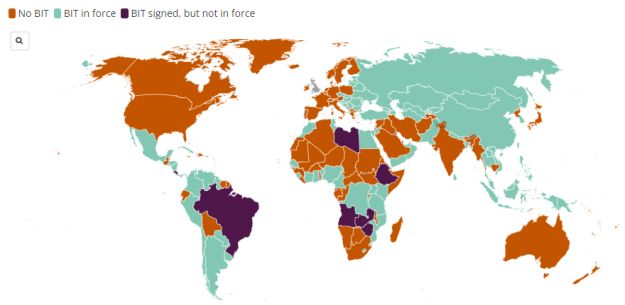OVERVIEW
Following Brexit, the UK Government is keen to boost trade with countries outside the EU. Our interactive maps show the extent of the UK's global network of free trade agreements and bilateral investment treaties. You may also be interested in our business-friendly guide to the UK-EU Brexit trade deal.
Last updated August 2023. In particular, the trade agreements map has been updated to reflect the UK's planned accession to the Comprehensive and Progressive Agreement for Trans-Pacific Partnership (CPTPP) and the countries that the UK is currently in talks with to establish new trade agreements or improve existing arrangements
FREE TRADE AGREEMENTS
The UK currently has free trade agreements in force with over 60 countries and is in the process of negotiating new trade agreements with a number of other territories. See the notes below for further explanation relating to this interactive map. The map allows you to zoom in on a particular geographic area. You can also look up a particular country by using the search box at the top left of the map.
Notes on the interactive map
When you click on a country with which the UK either has a free trade agreement or is in negotiations to conclude one, you can access additional information about that country as follows:
- Status: "Full ratification" means that the trade agreement has been fully ratified by the relevant state legislature(s). "Provisional application" means that although full ratification has yet to take place, the agreement is being applied on a provisional basis (and therefore businesses can benefit from it, notwithstanding the lack of formal ratification). "Agreed in principle" means that whilst negotiations are at an advanced stage and a formal agreement is more likely than not, it has yet to be signed and is not yet in force. "In negotiations" means that talks have commenced - see the "Additional notes" field for updates on progress.
- Type: "Continuity trade agreement" means an agreement which is largely based on a trade agreement originally put in place by the EU, from which the UK could benefit as an EU Member State. These agreements account for the majority of the UK's current network of free trade agreements. "New post-Brexit UK-specific deal" means an agreement which does not necessarily follow the same template as the "continuity trade agreements" (which were based on the EU's drafting). At the time of updating, the only such agreement in force was between the UK and Japan - but others are in the process of being negotiated or implemented (see below under the heading "New trade agreements").
- Total UK trade: These figures are based on 2021 data from the UK Department for International Trade. They do not necessarily reflect the total amount of trade with the relevant country which benefits directly from the provisions of the relevant trade agreement, which is likely to be lower than the total given. In some cases e.g. for EU countries, the figures provided are for the entire trading bloc (e.g. the EU), rather than for the individual country in question.
- Mutual recognition of product conformity?: Some trade agreements provide for countries to recognise each other's processes for testing certain products, particularly as regards safety issues. In practical terms, this means that tests to demonstrate compliance with the regulations of the country of import can in some cases be carried out by approved testing bodies in the country where the exporter is based and may not have to be repeated by equivalent bodies in the country of import. In some cases (e.g. the US), such arrangements exist in the form of a standalone agreement, independent of any free trade agreement. However, such mutual recognition arrangements are often confined to a limited range of goods (see, for example, the US-UK agreement noted above) and it should not be assumed that all products are covered.
- Customs cooperation?: Some trade agreements provide for countries to cooperate on customs matters, with a view to easing border red tape. In some cases (e.g. China), such arrangements exist in the form of a standalone agreement, independent of any free trade agreement.
New trade agreements
In 2023, new post-Brexit UK trade agreements came into force with Australia and New Zealand. The map indicates a number of other countries with which the UK is in the process of negotiating entirely new trade agreements (coloured light green). These include:
- the USA
- India
- the countries of the Gulf Cooperation Council (Bahrain, Kuwait, Oman, Qatar, Saudi Arabia and the United Arab Emirates).
The UK is also looking to expand its existing continuity trade agreements with Canada, Israel, Mexico, South Korea and Switzerland (these countries are coloured dark green because there is already a trade agreement in place with the UK; the negotiations are aimed at improving and updating it). Finally, the UK has negotiated digital trade agreements with a number of territories including Singapore and Ukraine. These typically supplement the existing trade arrangements.
CPTPP membership
In March 2023, the UK Government announced that negotiations for the UK to join the Comprehensive and Progressive Agreement for Trans-Pacific Partnership (CPTPP) had "substantially concluded". However, the CPTPP is not yet in force as regards trade between member countries and the UK; it will not take effect until all members have completed relevant legislative processes.
The UK's accession will take the total membership of the group to 12 states. The problem with displaying these on the map is that the UK already has bilateral trade agreements with 9 of the CPTPP's current members (Australia, Canada, Chile, Japan, Mexico, New Zealand, Peru, Singapore and Vietnam). For these countries, CPTPP membership is not indicated through use of a different colour, but in the Additional Notes field for the relevant country. The only other current CPTPP members are Brunei Darussalam and Malaysia. As the UK does not have existing bilateral trade agreements with these 2 countries, we have changed the colour coding to reflect the impact of the UK acceding to the CPTPP.
PLEASE NOTE: This information provides a high-level overview of the UK's free trade agreements and related arrangements such as agreements on customs cooperation or mutual recognition of product conformity. This is neither to be relied on as legal advice, nor is it intended to be a comprehensive overview or description of the provisions of those agreements. If you need more information, please get in touch. Much of the information was obtained from the UK Government's guidance on UK trade agreements with non-EU countries and its trade and investment factsheets.
BILATERAL INVESTMENT TREATIES
Bilateral Investment Treaties or BITs give investors from the UK protection where they make an investment in the "host state" (i.e. the other party to the BIT) - and vice versa where the other party's investors make investments in the UK. In particular, they allow the investor to take action in their own right to protect their investment or obtain compensation (as opposed to having to ask their own government to raise the matter on a state-to-state basis). For more detail, see BITs and the post-Brexit investment landscape.
As highlighted by our interactive map, the UK has an extensive network of BITs. This makes it a potentially attractive jurisdiction for incorporating investment vehicles which can then be used to invest in countries with which the UK has concluded a BIT. However, the BIT must have been brought into force - and the actual terms of the relevant BIT should always be reviewed to ascertain the level of protection offered. Some of the countries with which the UK has BITs are very small, but the map allows you to zoom in on particular geographic areas. You can also look up a particular country by using the search box at the top left of the map.
PLEASE NOTE: This information provides a high-level overview of the UK's Bilateral Investment Treaties. This is neither to be relied on as legal advice, nor is it intended to be a comprehensive overview or description of the provisions of those agreements. If you need more information, please get in touch. The information on BIT status was obtained from the UNCTAD International Investment Agreements Navigator and UK Treaties Online.
The content of this article is intended to provide a general guide to the subject matter. Specialist advice should be sought about your specific circumstances.





